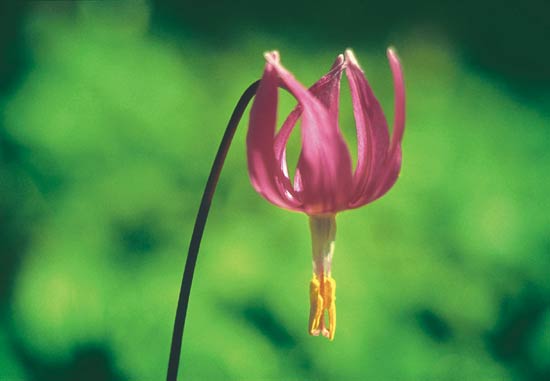Companion Plant: Erythronium revolutum
Bill Dale
Sidney, British Columbia, Canada
Erythronium origonum
is the native
Erythronium
of Oregon, Washington and the southern portion of British Columbia, but on Vancouver Island
Erythronium revolutum
takes over from just north of Duncan and extends up the coast as the predominant
Erythronium
.
Erythronium revolutum
is described in Lewis Clarke's book Wildflowers of British Columbia as being given the name "revolutum" because of the fact that when fully open the petals turn back on themselves. Clark published this book on wildflowers and used his picture of
E. revolutum
on the front cover of his coffee table book.

|
|
Erythronium revolutum
.
Photo by Bill Dale |
In 1938, a Mrs. Rorvik of Port Alberni, who was the wife of a fisheries officer, used to accompany her husband when he went out to Ucluelet and Tofino on Vancouver Island. George Fraser was a friend of her parents in Port Alberni and used to visit them as they too were Scottish. On one trip to Ucluelet Mrs. Rorvik took forty-two corms (or bulbs) to Fraser.
Erythronium revolutum
did not grow in Ucluelet. Fraser sent all forty-two corms to the Royal Botanic Garden, Kew, in England and claimed that in his opinion they were the most beautiful wildflower in Canada. I don't have any argument with this.
The curator at Kew sent Fraser a letter of thanks and asked him to thank Mrs. Rorvik. I assumed that Mrs. Rorvik was no longer with us but maybe she had some descendants. I found out two years ago that Mrs. Rorvik is still alive and lives a few miles from me.
Last year when we celebrated Fraser's 150th anniversary at Ucluelet, Mrs. Rorvik and her two daughters also were there. She is in her 95th year and bright as a button. She still lives by herself. She looks forward to when we celebrate George Fraser Day number 5 next year in Ucluelet.
At the zone where the
Erythronium origonum
and
E. revolutum
meet, and in my garden where I have many of each, the bees have been busy and have made several crosses. The results are beautiful with the flowers having pink petals of the
E. revolutum
and the distinctive colorful center of the
E. origonum
.
I have collected seed of
Erythronium revolutum
from the Sutton Creek area near Honeymoon Bay where there are thousands growing in deep sandy silt that is replenished each time the stream overflows its bank. The banks of Sutton Creek each summer are covered with areas of bracken that grows four to five feet tall, providing a cover that keeps the soil cool and damp. The seed is distributed by birds that ingest them and then drop them far afield.
To propagate from seed, I suggest the seed be sown separately in a pot or container. For the first two years it comes up and looks like a blade of grass. The third year it begins to have lily-like leaves and in the sixth or seventh year it will bloom and will have been well worth the wait.
Erythroniums
make wonderful companion plants for rhododendrons. They bloom in late April and then go dormant for the rest of the year. They are no trouble at all and are extremely beautiful among the rhododendrons. I have many erythroniums in my garden, which I have sold but which I expect to visit. Left alone they will multiply many times. They grow best when we still have damp ground from the winter rains but can survive easily in a dry summer as they go dormant.
Bill Dale is a member of the Cowichan Valley Chapter and a frequent writer on the life of George Fraser.